目录
1 -> 进程间通信介绍
1.1 -> 进程间通信目的
1.2 -> 进程间通信发展
1.3 -> 进程间通信分类
1.3.1 -> 管道
1.3.2 -> System V IPC
1.3.3 -> POSIX IPC
2 -> 管道
2.1 -> 什么是管道
2.2 -> 匿名管道
2.3 -> 实例代码
2.4 -> 用fork来共享管道原理
2.5 -> 站在文件描述符角度——深度理解管道
2.6 -> 站在内核角度——管道本质
3 -> 管道读写规则
4 -> 管道特点

1 -> 进程间通信介绍
1.1 -> 进程间通信目的
- 数据传输:一个进程需要将它的数据发送给另一个进程。
- 资源共享:多个进程之间共享同样的资源。
- 通知事件:一个进程需要向另一个或一组进程发送消息,通知它(它们)发生了某种事件(如进程终止时要通知父进程)。
- 进程控制:有些进程希望完全控制另一个进程的执行(如Debug进程),此时控制进程希望能够拦截另一个进程的所有陷入和异常,并能够及时知道它的状态改变。
1.2 -> 进程间通信发展
- 管道
- System V进程间通信
- POSIX进程间通信
1.3 -> 进程间通信分类
1.3.1 -> 管道
- 匿名管道pipe
- 命名管道
1.3.2 -> System V IPC
- System V消息队列
- System V共享内存
- System V信号量
1.3.3 -> POSIX IPC
- 消息队列
- 共享内存
- 信号量
- 互斥量
- 条件变量
- 读写锁
2 -> 管道
2.1 -> 什么是管道
- 管道是Unix中最古老的进程间通信的形式。
- 我们把从一个进程连接到另一个进程的一个数据流称为一个"管道"。
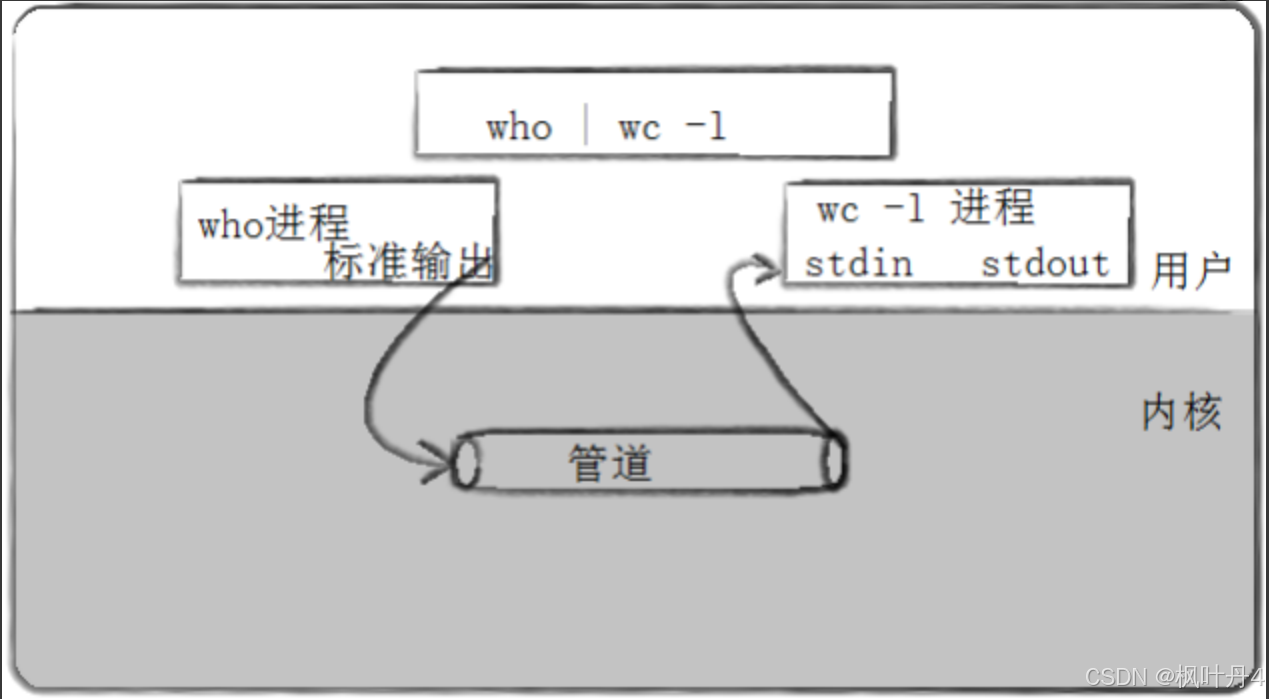
2.2 -> 匿名管道
#include <unistd.h>功能:创建一无名管道原型int pipe(int fd[2]);参数fd:文件描述符数组,其中fd[0]表示读端, fd[1]表示写端返回值:成功返回0,失败返回错误代码
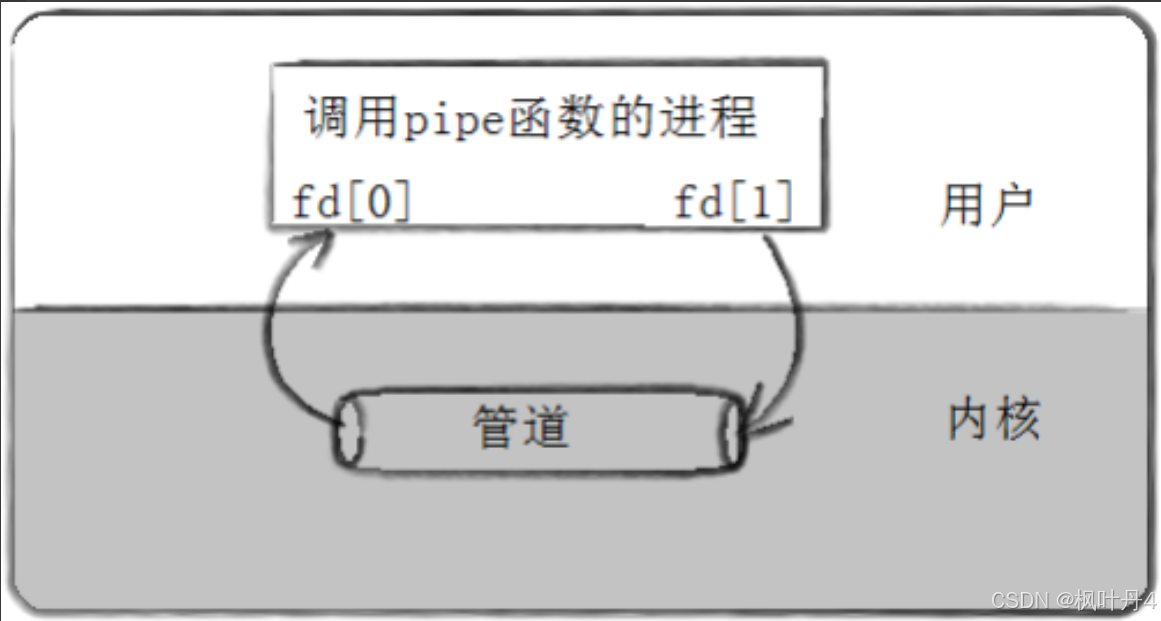
2.3 -> 实例代码
#define _CRT_SECURE_NO_WARNINGS 1//例子:从键盘读取数据,写入管道,读取管道,写到屏幕
#include <stdio.h>
#include <stdlib.h>
#include <string.h>
#include <unistd.h>int main(void)
{int fds[2];char buf[100];int len;if (pipe(fds) == -1)perror("make pipe"), exit(1);// read from stdinwhile (fgets(buf, 100, stdin)) {len = strlen(buf);// write into pipeif (write(fds[1], buf, len) != len) {perror("write to pipe");break;}memset(buf, 0x00, sizeof(buf));// read from pipeif ((len = read(fds[0], buf, 100)) == -1) {perror("read from pipe");break;}// write to stdoutif (write(1, buf, len) != len) {perror("write to stdout");break;}}
}2.4 -> 用fork来共享管道原理
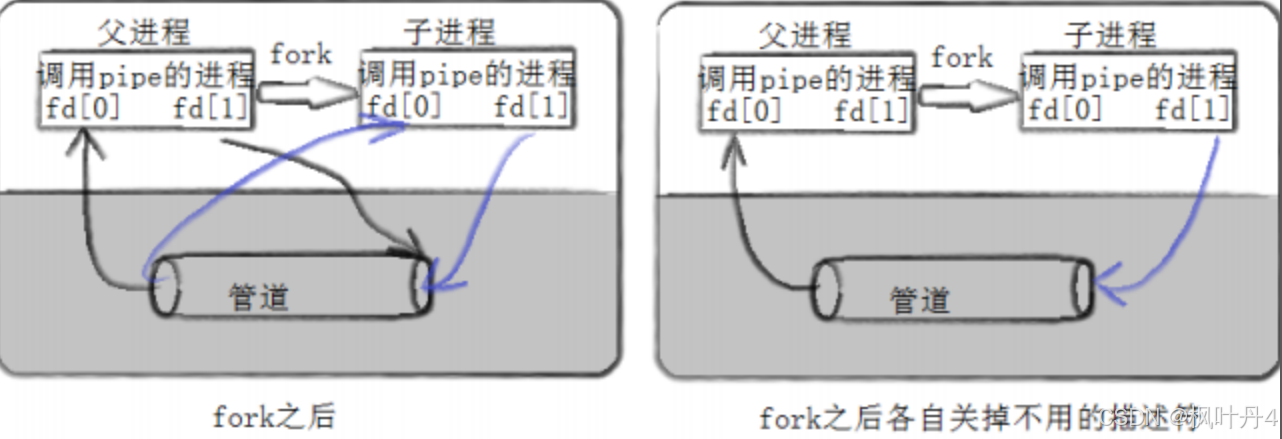
2.5 -> 站在文件描述符角度——深度理解管道

2.6 -> 站在内核角度——管道本质
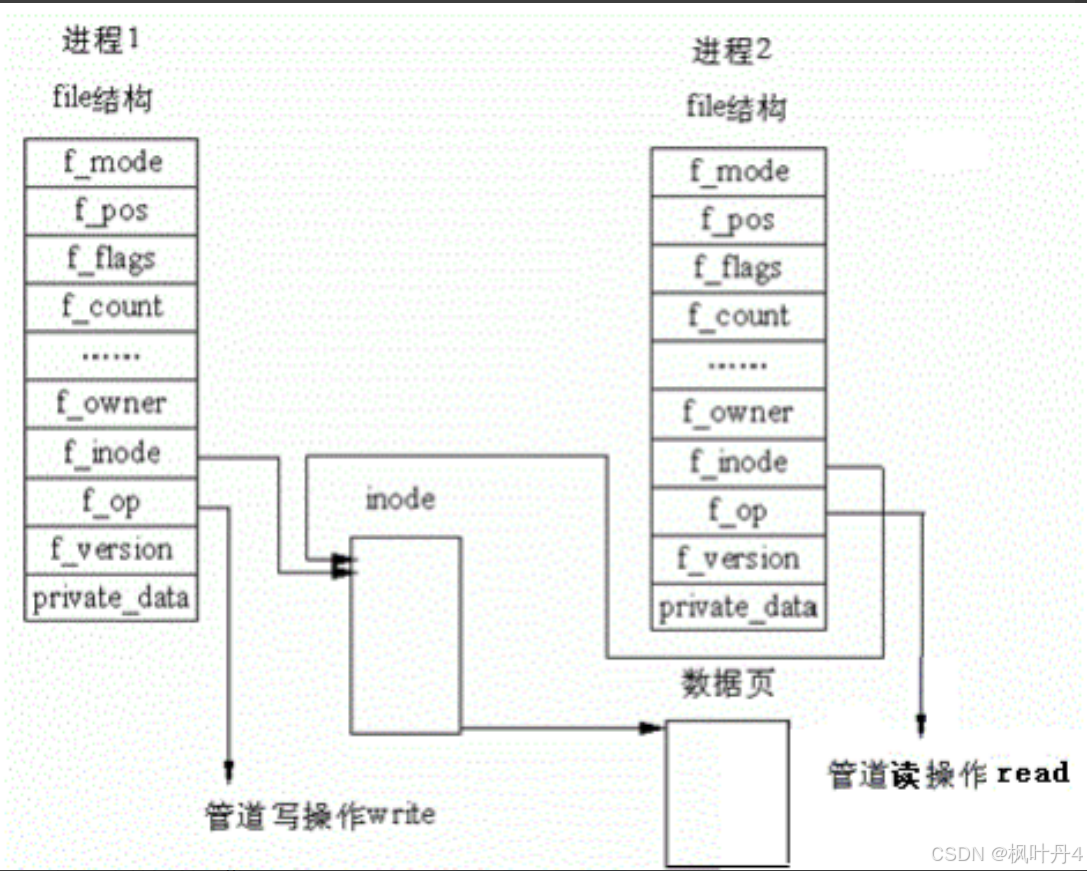
所以,看待管道,就如同看待文件一样!管道的使用和文件一致,迎合了"Linux一切皆文件思想"。
#include <unistd.h>
#include <stdlib.h>
#include <stdio.h>
#include <errno.h>
#include <string.h>#define ERR_EXIT(m) \ do \ { \ perror(m); \ exit(EXIT_FAILURE); \ } while(0)
int main(int argc, char* argv[])
{int pipefd[2]; if (pipe(pipefd) == -1) ERR_EXIT("pipe error");pid_t pid;pid = fork();if (pid == -1)ERR_EXIT("fork error");if (pid == 0) {close(pipefd[0]);write(pipefd[1], "hello", 5);close(pipefd[1]);exit(EXIT_SUCCESS);}close(pipefd[1]);char buf[10] = { 0 };read(pipefd[0], buf, 10);printf("buf=%s\n", buf);return 0;
}例1. 在minishell中添加管道的实现:
# include <stdio.h>
# include <stdlib.h>
# include <unistd.h>
# include <string.h>
# include <fcntl.h># define MAX_CMD 1024char command[MAX_CMD];int do_face()
{memset(command, 0x00, MAX_CMD);printf("minishell$ ");fflush(stdout);if (scanf("%[^\n]%*c", command) == 0) {getchar();return -1;}return 0;
}char** do_parse(char* buff)
{int argc = 0;static char* argv[32];char* ptr = buff;while (*ptr != '\0') {if (!isspace(*ptr)) {argv[argc++] = ptr;while ((!isspace(*ptr)) && (*ptr) != '\0') {ptr++;}}else {while (isspace(*ptr)) {*ptr = '\0';ptr++;}}}argv[argc] = NULL;return argv;
}int do_redirect(char* buff)
{char* ptr = buff, * file = NULL;int type = 0, fd, redirect_type = -1;while (*ptr != '\0') {if (*ptr == '>') {*ptr++ = '\0';redirect_type++;if (*ptr == '>') {*ptr++ = '\0';redirect_type++;}while (isspace(*ptr)) {ptr++;}file = ptr;while ((!isspace(*ptr)) && *ptr != '\0') {ptr++;}*ptr = '\0';if (redirect_type == 0) {fd = open(file, O_CREAT | O_TRUNC | O_WRONLY, 0664);}else {fd = open(file, O_CREAT | O_APPEND | O_WRONLY, 0664);}dup2(fd, 1);}ptr++;}return 0;
}int do_command(char* buff)
{int pipe_num = 0, i;char* ptr = buff;int pipefd[32][2] = { {-1} };int pid = -1;pipe_command[pipe_num] = ptr;while (*ptr != '\0') {if (*ptr == '|') {pipe_num++;*ptr++ = '\0';pipe_command[pipe_num] = ptr;continue;}ptr++;}pipe_command[pipe_num + 1] = NULL;return pipe_num;
}int do_pipe(int pipe_num)
{int pid = 0, i;int pipefd[10][2] = { {0} };char** argv = { NULL };for (i = 0; i <= pipe_num; i++) {pipe(pipefd[i]);}for (i = 0; i <= pipe_num; i++) {pid = fork();if (pid == 0) {do_redirect(pipe_command[i]);argv = do_parse(pipe_command[i]);if (i != 0) {close(pipefd[i][1]);dup2(pipefd[i][0], 0);}if (i != pipe_num) {close(pipefd[i + 1][0]);dup2(pipefd[i + 1][1], 1);}execvp(argv[0], argv);}else {close(pipefd[i][0]);close(pipefd[i][1]);waitpid(pid, NULL, 0);}}return 0;
}int main(int argc, char* argv[])
{int num = 0;while (1) {if (do_face() < 0)continue;num = do_command(command);do_pipe(num);}return 0;
}3 -> 管道读写规则
- 当没有数据可读时:
- O_NONBLOCK disable:read调用阻塞,即进程暂停执行,一直等到有数据来到为止。
- O_NONBLOCK enable:read调用返回-1,errno值为EAGAIN。
- 当管道满的时候:
- O_NONBLOCK disable: write调用阻塞,直到有进程读走数据。
- O_NONBLOCK enable:调用返回-1,errno值为EAGAIN。
- 如果所有管道写端对应的文件描述符被关闭,则read返回0。
- 如果所有管道读端对应的文件描述符被关闭,则write操作会产生信号SIGPIPE,进而可能导致write进程退出。
- 当要写入的数据量不大于PIPE_BUF时,linux将保证写入的原子性。
- 当要写入的数据量大于PIPE_BUF时,linux将不再保证写入的原子性。
4 -> 管道特点
- 只能用于具有共同祖先的进程(具有亲缘关系的进程)之间进行通信;通常,一个管道由一个进程创建,然后该进程调用fork,此后父、子进程之间就可应用该管道。
- 管道提供流式服务。
- 一般而言,进程退出,管道释放,所以管道的生命周期随进程。
- 一般而言,内核会对管道操作进行同步与互斥。
- 管道是半双工的,数据只能向一个方向流动;需要双方通信时,需要建立起两个管道。
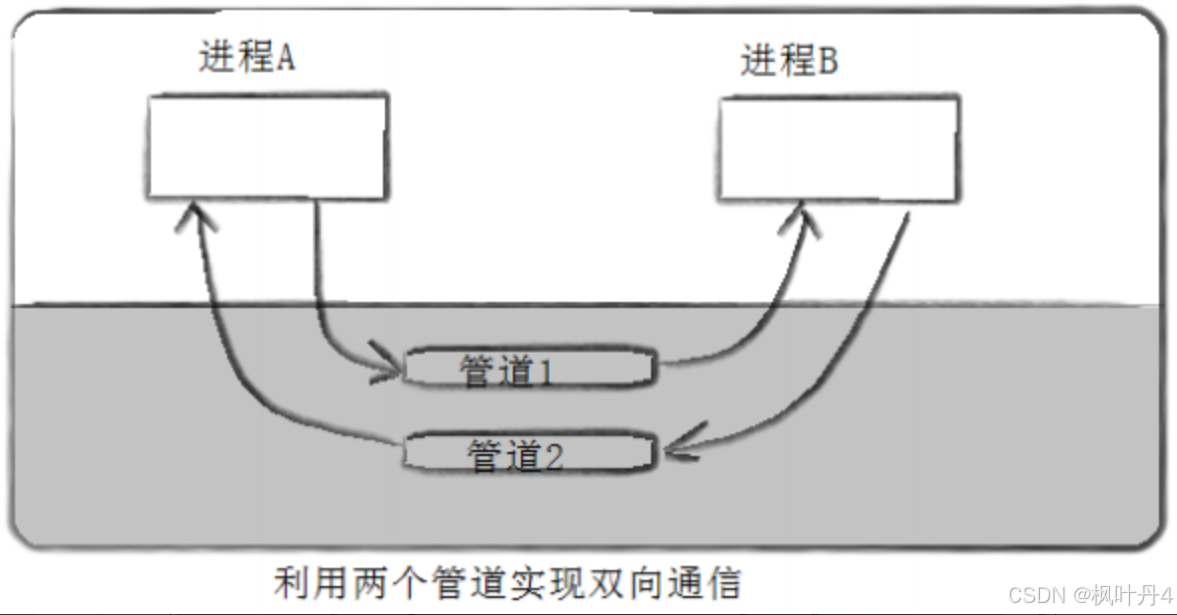
感谢各位大佬支持!!!
互三啦!!!

![[NewStarCTF 2023 公开赛道]Begin of PHP1](https://i-blog.csdnimg.cn/direct/68a3e9514c964e968c63c0180722c568.png)

















